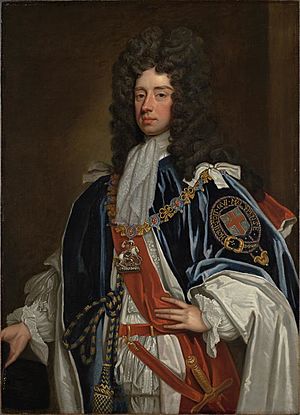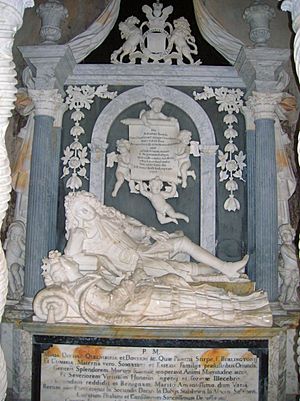James Douglas, 2nd Duke of Queensberry facts for kids
Quick facts for kids
The Duke of Queensberry
|
|
|---|---|
 |
|
| Secretary of State for Scotland | |
| In office 3 February 1709 – 6 July 1711 |
|
| Monarch | Anne |
| Preceded by | The Earl of Mar |
| Succeeded by | The Earl of Mar |
| Lord High Commissioner | |
| In office 31 July 1706 – 1 May 1707 |
|
| Monarch | Anne |
| Preceded by | The Duke of Argyll |
| In office 25 April 1700 – 31 May 1704 |
|
| Monarch | William II; Anne |
| Preceded by | The Earl of Marchmont |
| Succeeded by | The Marquess of Tweeddale |
| Personal details | |
| Born | 18 December 1662 Sanquhar Castle, Dumfriesshire Scotland |
| Died | 6 July 1711 (aged 48) Mayfair, London, England |
| Resting place | Durisdeer Parish Church, Durisdeer, Dumfries and Galloway |
| Spouse | Hon. Mary Boyle (c. 1664–1709) |
| Children |
|
| Parents |
|
James Douglas, 2nd Duke of Queensberry and 1st Duke of Dover (born December 18, 1662 – died July 6, 1711) was an important Scottish nobleman and politician. He lived in the late 1600s and early 1700s. He played a key role in creating the Kingdom of Great Britain. He did this by helping to negotiate and pass the Acts of Union 1707 with England.
Contents
Life and Political Career
James Douglas was the oldest son of William Douglas, 1st Duke of Queensberry. His mother was Isabel Douglas. Before he became Duke, people called him Lord Drumlanrig.
He studied at the University of Glasgow. In 1684, he became a Privy Counsellor in Scotland. This meant he was a trusted advisor to the King. He also served in the military. He supported King William III in 1688.
When his father passed away in 1695, James inherited several important titles. These included becoming the 2nd Duke of Queensberry.
Important Roles and Achievements
James Douglas held many high-ranking jobs in Scotland:
- From 1693, he was the Lord High Treasurer of Scotland. This role was like being in charge of the country's money.
- From 1695 to 1702, he was the Keeper of the Privy Seal of Scotland. This person was responsible for the King's official seal on important documents.
- In 1696, he became an Extraordinary Lord of Session. This was a special judge position.
He served as Lord High Commissioner to the Parliament of Scotland several times (in 1700, 1702, and 1703). In this role, he represented the monarch in the Scottish Parliament. He helped end the Darien scheme, which was a Scottish plan to set up a colony in Panama that failed badly. In 1701, he was made a Knight of the Garter. This is a very high honor.
Working with Queen Anne
When Queen Anne became queen in 1702, James Douglas was appointed Secretary of State for Scotland. This job involved managing Scotland's affairs.
He was involved in a political situation where he was tricked by Simon Fraser, 11th Lord Lovat. This led to him stepping back from government in 1704.
However, he returned to power in 1705 as Keeper of the Privy Seal of Scotland. He played a crucial part in the Treaty of Union in 1707. This treaty joined Scotland and England, creating Great Britain. Because of this, he was not very popular in Scotland, but he received a yearly payment from the government.
In 1708, he was given new titles in Great Britain, including Duke of Dover. He also joined the British Privy Council. He continued to serve as Secretary of State for Scotland from 1709 until he died in 1711. He passed away from a serious stomach illness in London. He was later buried with his wife in Durisdeer Parish Church in Scotland.
Today, Queensberry House in Edinburgh is part of the Scottish Parliament Building.
Family Life
James Douglas married Mary Boyle. They had at least three children:
- James (1697–1715): He had health challenges and did not inherit all his father's titles. He died young and did not marry or have children.
- Charles (1698–1778): He became the 3rd Duke of Queensberry after his father. He had two sons, but they both died without children.
- Jane (1701–1729): She married The Earl of Dalkeith. Her children eventually inherited the family's estates.


